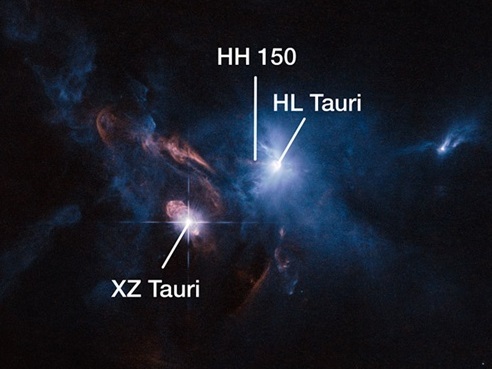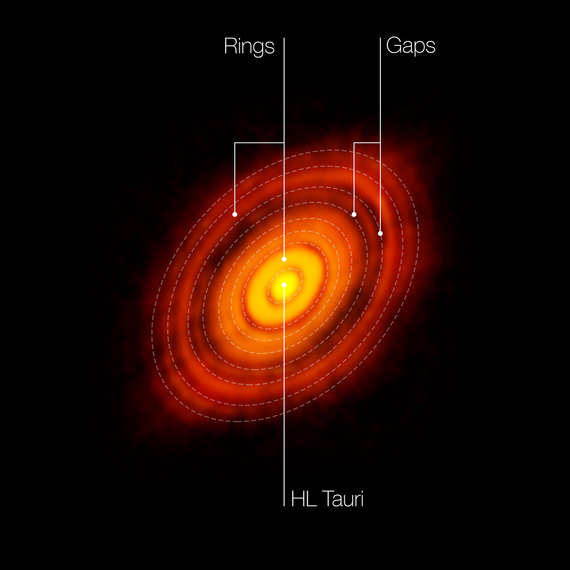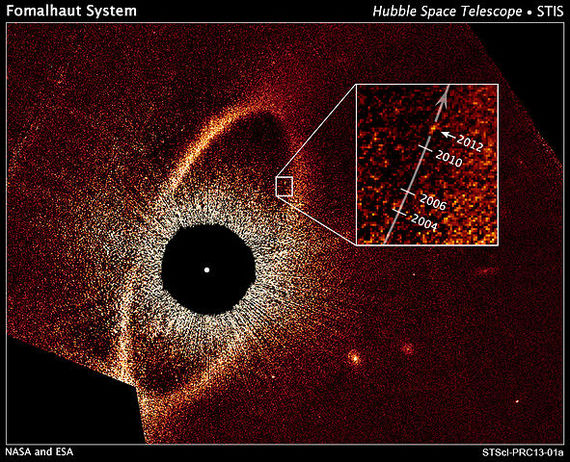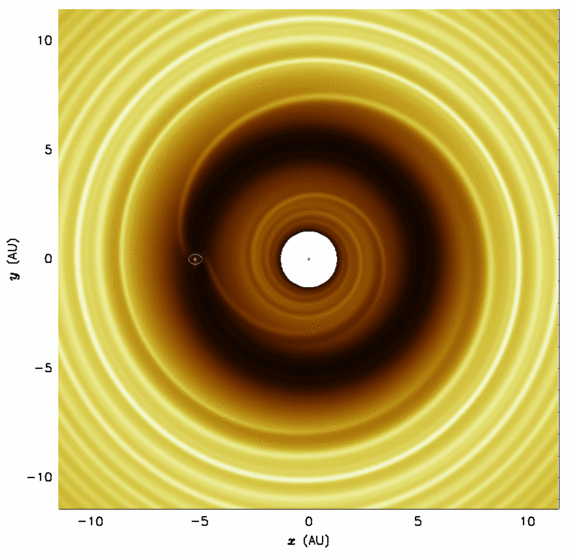About 450 light-years from Earth, in the constellation Taurus, a dense, dark, interstellar cloud has slowly started to reveal its secrets. It happens to be a very active nursery for young stars resembling our own sun about 4.6 billion years ago. Embedded in this cloud, which has been carefully studied by the Hubble Space Telescope, are very young stars called HL Tau and XZ Tau, each no more than 1 million years old, give or take. You can easily see the nebulae formed by the complex blobs of gas ejected by the young stars.
 HL Tauri and surroundings (credit: NASA/HST)
HL Tauri and surroundings (credit: NASA/HST)
The star HL Tau (more properly called HL Tauri) is 10,000 times too faint for you to see with your naked eye. Even a large telescope has a hard time seeing it clearly through all the dust and gas blocking the view. But other kinds of telescopes can easily pierce the light-years of dust clouds. Since 1975, astronomers had known that HL Tau had some kind of disk of gas orbiting it. The disk is about 40 times the diameter of our solar system. Later on, astronomers studied HL Tau using radio telescopes and detected a dense knot of carbon monoxide molecules centered on the star. Caltech astronomers Anneila Sargent and Steven Beckwith were able to study this clump in more detail and discovered it really was a disk-like region rotating in the same way that planets orbit our sun: faster toward the center and slower toward the edge. Based on observations made in 1986 from the Millimeter Wave Interferometer of the Owens Valley Radio Observatory, it was determined that the disk had about 10-percent as much mass as our sun. Though not enough to build a second companion star, it would be plenty to make a lot of planets, with dust and gas to spare and throw away into the surrounding Taurus dust cloud.
In addition to dust and carbon monoxide molecules, astronomers had also detected water ice in 1975, and micron-sized silicate ("beach sand") dust grains in 1985. Searches for methane ice in the very cold outer limits of the disk haven't turned up anything yet. HL Tau's disk seems to be pretty bland in terms of interesting pre-life molecules! But its boringly simple, or absent, chemistry is countered by the disk being a very complex and active region of space. Along the axis of the spinning disk, small nebulae called Herbig-Haro objects can be seen several light-years away, such as HH-150 and six cloud clumps aligned along a jet called HH-151. These gas clouds are like puffs of smoke being ejected at very high speeds by events happening as the HL Tau interacts with its surrounding disk. We still don't know exactly what is going on after all these years. Could magnetic fields be involved?
Recent studies of the magnetic field of this disk by astronomers Ian Stephens and Leslie Looney led to a surprising result: Instead of the field oriented with a distinct axis pointing along the HH151 jet, the field was much more complex. It was always thought that the blobs of gas would be ejected along some well-defined axis provided by the magnetic field, like the barrel of a cannon. In the absence of an ordered "poloidal" magnetic field to define a unique direction, the cause of the cloud alignment in the jet remains a mystery. To make matters more interesting, in 2007, astronomer Michihiro Takami, using the Subaru Telescope, detected the faint emission from a counter-jet also aligned with the HH-151 jet and HL Tau. So whatever the events that are occurring in this disk of gas and dust, it tends to favor ejecting two streams of matter in a symmetric way along the polar axis of the disk.
Once astronomers caught the scent of the nearby HL Tau dust disk, there was only one direction to go: higher resolution to see more details and how the disk is actually shaped. By 2011, astronomers Woojin Kwon, Leslie Looney and Lee Mundy had used the Combined Array for Research in Millimeter-wave Astronomy and detected a flattened shape. It is not face-on but tilted so it looks like an ellipse inclined slightly downwards to the line of sight. The measurements also suggested that the larger dust grains in the disk, possibly as big as sand grains, had settled toward the plane of the disk and a halo of finer micron-sized dust grains probably engulfs the whole disk. The disk is also gravitationally unstable, but they were not able to see any details of the kinds of shapes that result.
Then, in 2014, astronomers used the even higher-resolution capabilities of the new Atacama Large Millimeter Array (ALMA) to create the now-famous image you have seen on the nightly news. What it confirms is all the previous observations about the size, shape and tilt of the dust disk, but it also could begin to see some of the details of its internal shape. What astronomers found was simply amazing. As many as eight dark bands concentric with the star can easily be seen! The gaps are about 450 million to 1 billion miles wide. What are they?
 The HL Tauri protoplanetary disk (credit: ESA/ALMA)
The HL Tauri protoplanetary disk (credit: ESA/ALMA)
The system is less than 1 million years old, and this seems too short a time to form planets within these dark rings -- but who knows? Could you really form Jupiter-sized, dust vacuum cleaners in less than a million years? Some calculations using gravitational instabilities in the disk have predicted Jupiter formation times as short as 100,000 years! This is not the first time such rings have been seen. In 2005, the Hubble Space Telescope found a dark ring in the disk surrounding the star TW Hydraelocated 176 light-years from Earth. The ring is 2 billion miles wide and 8 billion miles from its star and, like HL Tau's rings, may eventually reveal a forming Jupiter-sized planet.
Meanwhile, Hubble has just completed a survey of debris disks orbiting a number of stars that are no longer enshrouded by dust clouds. The collection of 23 stars reveals some interesting clues to how these disks evolve in time between 10 million and 1 billion years after planet formation has probably stopped. The large planet seen by Hubble orbiting inside the debris disk of the bright star Fomalhaut is probably the last stages of such a planet-forming disk system. Meanwhile, the disk irregularities observed around the star HD 181327 resemble a huge spray of debris possibly caused by the recent collision of two bodies. When our infant Earth was struck by a Mars-sized planet to form our Moon, a similar spray of debris probably formed!
 Fomalhaut debris disk and planet (credit: NASA/HST)
Fomalhaut debris disk and planet (credit: NASA/HST)
Theoretical Work: A Story in Progress
For decades, astronomers have worked with supercomputer simulations of the basic laws of gravity, fluid and gas dynamics and radiation transport to create physically consistent models of what these protoplanetary disks should look like as they evolve over time. The mechanism of planet formation has also been explored through a variety of calculations and physics-based models. For example, astronomers Phil Armitage at the University of Colorado and Wilhelm Kley at Tubingen University have arrived at similar models for how a massive planet like Jupiter forms from such a disk and excavates a swept-out ring that resembles the HL Tau rings. The models show how the planet attracts mass from the edges of the ring, and how the process develops spiral "gravity waves" in the disk that then cause the orbit of the forming planet to change over time. Other simulations like the ones by Ken Rice at the University of California, Riverside, show that for much more massive disks, gravitational instabilities can lead to very rapid large-planet formation and the creation of a strong spiral wave resembling what you see in the shape of a spiral galaxy.
 A forming planet and ring (credit: Wilkelm Kley/Tubingen)
A forming planet and ring (credit: Wilkelm Kley/Tubingen)
So the addition of new high-resolution data like that for HL Tau is at long last allowing astronomers to see the hidden details of planet and disk formation and, from this, create the next-generation physics-based models for how planets form. The rings are still something of a mystery and may not actually involve planet sweeping. Until we can detect an actual planet inside one of these rings, this connection is still an unproven theoretical possibility.
Stay tuned for new discoveries and more clues to how our own solar system formed!








